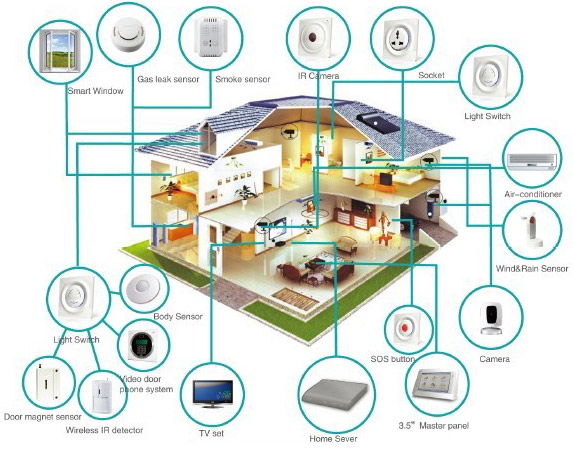Smart homes are still only a small part of the total UK housing stock, but they – along with the automation of other buildings – are becoming more and more important because the technologies not only improve comfort, but can also save lots of energy and money, as James Hunt reports:

By next year, the UK home automation market is estimated to be worth £156 million – over double what it was in 2011 – and is sure to expand much further. This rapid growth is being driven by technological advances, which are making smart home systems simultaneously more affordable, more functional and easier to install and commission.
But the growth is also being pushed by climate change related legislation and the need to save both energy and reduce carbon emissions. The energy savings result mainly from presence detection plus careful control of lighting and heating so that neither is on when it’s not actually needed, or is at least reduced. The same goes for appliances.
So home automation is no longer only about comfort and easy control of your home cinema system; it now covers the optimum control of everything from lighting, heating, window blinds, communications – as well as, yes, entertainment. Smart meters will also become increasingly important components of smart homes.
Smart home and building automation systems now encompass both hard-wired and wireless systems of various types, with wireless (radio frequency) and Internet systems becoming ever more important – partly because with retrofits, far less damage and disruption occurs than with installing new wiring systems, and party because of the communication possibilities offered.
Today, the focus has turned firmly towards more standardised ‘open’ systems, rather than the many earlier proprietary protocols, which rarely communicated with other systems. Some of the best-known protocols include KNX, ZigBee, Bluetooth and LightwaveRF.
The growing IoT influence
This scenario is now joined by the even faster growing Internet of Things (IoT), which is starting to provide a vast and diverse range of connected smart devices (smart thermostats, lighting, security and access systems and medical systems to name just a very few), which fit perfectly into the smart home universe.
The IoT, where the many objects in a smart home all talk to each other over the Internet, is the next evolution of the ‘Net’ where devices of all types and capabilities are connected through Internet Protocol and web services.
In addition to allowing enabled products to communicate, the IoT also allows the measurement, monitoring, and analysis of consumer behaviours, which can (and doubtless will) be used to help shape product developments in the future. The IoT is truly a revolutionary development that will have a large positive effect on the smart home and building automation sectors – although there are downsides too; security and privacy especially.
ARM (www.arm.com), which provides architectures for the digital world, says that in a decade’s time, 30% of broadband households will have a smart system, while around 65% of households will have multiple systems by 2017. ARM believes that there will be a general migration from machine-to-machine (M2M) control to the IoT, which will enable ‘massive opportunities in the smart home’.
The IoT is already a rapidly expanding reality, with many tens of billions of devices predicted to be connected by 2020. Learn more by going to: www.voltimum.co.uk/topic/internet-things
For commercial and other buildings too
Buildings other than the purely domestic can and do benefit from such technologies, and the demand for energy saving, comfort and versatility in the management of lighting, HVAC and access control systems in offices, public, retail and industrial buildings is fast increasing. Likewise, this can only be achieved efficiently and cost-effectively using intelligent control.
Building automation is the automatic and centralised control of a building's HVAC, lighting and other systems through a Building Management System (BMS) or Building Automation System (BAS). The objectives are greater comfort, more efficient building system operation, and a reduction in energy consumption and operating costs.
Such building automation is an example of a distributed control system, which is the computer networking of electronic devices designed to monitor and control the mechanical, security, fire and flood safety, lighting (especially emergency lighting) and HVAC systems in larger buildings.
Many opportunities
With so many developments taking place so fast, Voltimum UK electrical contracting and installation users should be able to benefit from these fast expanding markets. UK electrical contractors and installers can surely benefit from them.
To learn more, please read the other articles in this VoltiTECH. To see earlier VoltiTECHs on smart homes and building automation, please use the links below.